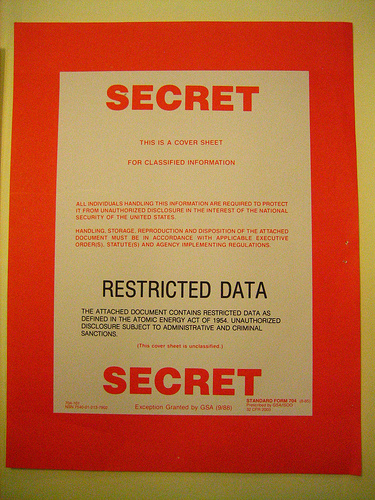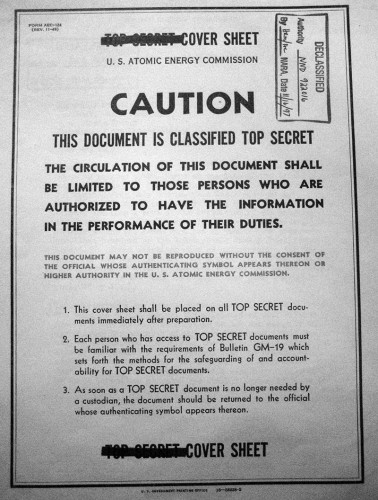“Cover sheets” are pieces of paper that you put on top of a folder to indicate its classification status. They presumably exist to allow people with clearances to know, at a glance, what the highest level of classification of documents in a given folder is, without actually opening up the folder. They’re a reasonably simple part of the practice of secrecy: they help you quickly determine how secret something is supposed to be.
Today these are rather standardized. Below is one for SECRET/RESTRICTED DATA that I came across in the National Archives, denoting a variety of different classification statuses. My guess, based on the various form numbers assembled on them, is that this model form dates from the late 1980s, but it might be more recent than that.
These are terribly dull, but very effective. They scream out to you pretty vividly how fearfully they should be regarded, they are pretty unambiguous in their meaning, and they’re on attractive card stock. They tell you both what it is, and what you should be doing (or not doing) to the contents. These things are littered throughout the files of the Atomic Energy Commission.
Let’s look at some earlier models, though.
Here is one that was developed in late 1949 but used through at least the early 1950s:
This one is much more visually interesting. The font choice is very early Cold War, is it not? Not quite as scary as the 1980s version. I don’t think you could get away with using a Lithos-like font for something this serious today, but there’s something about its apparent frivolity that strikes me as even more disturbing than the sea of Helvetica that is the coversheet from the 1980s. There’s a casual quality to its warnings. “Hey there, chum. Better treat this document correctly, or we’ll send you to the electric chair!”
The cover sheets didn’t always look so slick, though. When the “Top Secret” classification category was formally created in 1944, the classification bureaucracy was a lot less formalized.
General Leslie Groves, military head of the Manhattan Project, used very idiosyncratic looking “Top Secret” cover sheets:
This one is from May 1945, attached to the “Rules for Public Release” that governed what was allowed to be published in the final version of the Smyth Report. As you can see, these cover sheets also served as logs as to whom the documents had been given to, when people had requested it (in the above document, Groves himself checked it out a few times), how many copies were made, and other “metadata.”
That loopy script at the top was common to all of Groves’ “Top Secret” sheets. I can’t help but wonder who came up with it. I almost want there to be little hearts above any dotted i’s — it has an especially whimsical appearance. A few Lisa Frank stickers and it could be in a high schooler’s binder.
Looking at the full spread of these, it’s hard not to take away the conclusion that in their quest for appearing serious about secrecy, the U.S. government has gotten increasingly dull in its graphics design. This is, I am fairly sure, one of the least significant criticisms of secrecy ever to be leveled, but hey, you heard it here first…





The typeface in the early 1950s one is reminiscent of the Futura Bold that was used by NASA to label spacecraft controls. I don’t believe it would have appeared as frivolous to contemporary readers – the intention behind such typefaces at the time was to mark the text as neutrally informative.
Agreed, of course. The reason the “neutral” style of the 1950s looks so stylish today is because our standards of “neutral” have changed. Relatedly, Futura Bold now has a “space age” feel to it, no doubt because of its prevalence as a “neutral” style in the 1950s. One can only hope that slabs of Helvetica will someday evoke such nostalgia of our present era, decades into the future, after Comic Sans finally achieves its success as the new “neutral” standard. (Joking, of course… or am I?)
The red coversheet for secret material is still in use today.
While I love the font on General Groves’ coversheet and I think we should be using more fun fonts, I appreciate the bold red on the current coversheet. It makes it immediately identifiable as Secret, and red is a color that stands out to most people. I haven’t seen the broad red outline/band (or blue for confidential) used elsewhere. The uniqueness and the immediately identifiable nature of the coversheet is a huge security aid.
1944 as the date for the invention of “TOP SECRET” is a surprise to me. I was always given to understand that UK use of MOST SECRET was discontinued during WW2 (probably pre-1944) and replaced with TOP SECRET to allow for interoperability with the US.